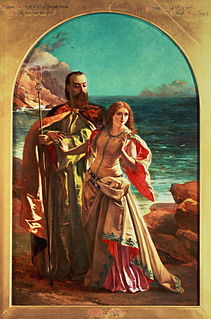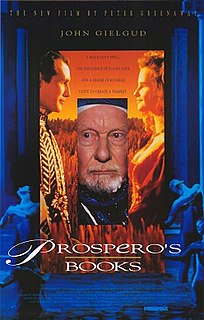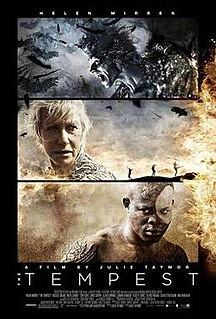
Prospero is a fictional character and the protagonist of William Shakespeare's play The Tempest. Prospero is the rightful Duke of Milan, whose usurping brother, Antonio, had put him to sea on a "rotten carcass" of a boat to die, twelve years before the play begins. Prospero and Miranda had survived and found exile on a small island. He has learned sorcery from books, and uses it while on the island to protect Miranda and control the other characters.

Return to the Forbidden Planet is a jukebox musical by Bob Carlton, based on Shakespeare's play The Tempest and the 1956 science fiction film Forbidden Planet, which is itself loosely based on The Tempest. The show features a score of 1950s and '60s rock and roll classics and dialogue largely adapted from well-known passages from Shakespeare.
Caliban, son of the witch Sycorax, is an important character in William Shakespeare's play The Tempest.

Miranda is one of the principal characters of William Shakespeare's The Tempest. She is the only female character to appear on stage.

Prospero's Books is a 1991 British avant-garde film adaptation of William Shakespeare's The Tempest, written and directed by Peter Greenaway. Sir John Gielgud plays Prospero, the protagonist who provides the off-screen narration and the voices to the other story characters. As noted by Peter Conrad in The New York Times on 17 November 1991, Greenaway intended the film “as an homage to the actor and to his "mastery of illusion." Sir John's Prospero is Shakespeare, and having rehearsed the action inside his head, speaking the lines of all the other characters, he concludes the film by sitting down to write The Tempest.”

George T. Delacorte Jr. was an American magazine publisher, born in New York City.
The Tempest is an opera by English composer Thomas Adès with a libretto in English by Meredith Oakes based on the play The Tempest by William Shakespeare.

The Tempest is a 1979 film adaptation of William Shakespeare's play of the same name. Directed by Derek Jarman, produced by Don Boyd, with Heathcote Williams as Prospero, it also stars Toyah Willcox, Jack Birkett and Helen Wellington-Lloyd from Jarman's previous feature, Jubilee (1977), as well as his long-time cohort Karl Johnson.

Sycorax is an unseen character in William Shakespeare's play The Tempest (1611). She is a vicious and powerful witch and the mother of Caliban, one of the few native inhabitants of the island on which Prospero, the hero of the play, is stranded.
Gonzalo is a fictional character in William Shakespeare's The Tempest.

Stephano is a boisterous and often drunk butler of King Alonso in William Shakespeare's play, The Tempest. He, Trinculo and Caliban plot against Prospero, the ruler of the island on which the play is set and the former Duke of Milan in Shakespeare's fictional universe. In the play, he wants to take over the island and marry Prospero's daughter, Miranda. Caliban believes Stephano to be a god because he gave him wine to drink which Caliban believes healed him.
Milton Elting Hebald was a sculptor who specialized in figurative bronze works. Twenty-three of his works are displayed in public in New York City, including the statues of Romeo and Juliet and The Tempest in front of the Delacorte Theatre in Central Park. His major work is a 220-foot (67 m), 12-piece "Zodiac Screen", then the largest sculpture in the world, commissioned by Pan-American Airlines for its terminal at John F. Kennedy International Airport, and now owned and stored by the Port Authority of New York and New Jersey.

The Tempest is a 2010 American film based on the play of the same name by William Shakespeare. In this version, the gender of the main character, Prospero, is changed from male to female; the role was played by Helen Mirren. The film was written and directed by Julie Taymor and premiered at the Venice Film Festival on September 11, 2010.

The Journey to Melonia is a 1989 Swedish animated fantasy adventure film directed by Per Åhlin, very loosely based on William Shakespeare's The Tempest. It was Per Åhlin's first fully animated feature film, since his earlier films Out of an Old Man's Head and Dunderklumpen! had both used a mix of animation and live action. The full English title is The Journey to Melonia: Fantasies of Shakespeare's 'The Tempest'.
Ferdinand is the prince of Naples and the son of Alonso, the King of Naples, in Shakespeare's play, The Tempest. He falls in love with Miranda. He is quick to promise the title of queen and wife to Miranda even though he doesn't know her name. He is happy in humble labours, blinded by love. He makes a solemn vow to be truthful to Prospero, and not to violate Miranda's chastity before their wedding.

The Tempest is a play by English playwright William Shakespeare, probably written in 1610–1611, and thought to be one of the last plays that Shakespeare wrote alone. After the first scene, which takes place on a ship at sea during a tempest, the rest of the story is set on a remote island, where the sorcerer Prospero, a complex and contradictory character, lives with his daughter Miranda, and his two servants—Caliban, a savage monster figure, and Ariel, an airy spirit. The play contains music and songs that evoke the spirit of enchantment on the island. It explores many themes, including magic, betrayal, revenge, and family. In Act IV, a wedding masque serves as a play-within-a-play, and contributes spectacle, allegory, and elevated language.
Une Tempête is a 1969 play by Aimé Césaire. It is an adaptation of Shakespeare's The Tempest from a postcolonial perspective, set on an island in the Caribbean. The play was first performed at the Festival d'Hammamet in Tunisia under the direction of Jean-Marie Serreau. It later played in Avignon and Paris. Césaire uses all of the characters from Shakespeare's version, with some additions and new renderings of the original cast.

Romeo and Juliet is an outdoor bronze sculpture depicting Romeo and Juliet by American artist Milton Hebald, located in front of Delacorte Theater in Manhattan's Central Park, in the United States. It is one of two companion works at the theater sculpted by Hebald, the other being The Tempest (1966). Unveiled in 1977 and cast in 1978, Romeo and Juliet was donated by philanthropist George T. Delacorte, Jr. The sculpture is 7 feet (2.1 m) tall; the two figures, shown embracing, are set on a granite pedestal. A cast from the same mold appears in the rose garden at the Hollenbeck Palms retirement community in Boyle Heights, Los Angeles.
The Tempest is a 1960 American TV movie based on the play by William Shakespeare. It was directed by George Schaefer, who said the play was ideal for TV because it could be easily done in 90 minutes.

The Tempest is a 1908 British-made silent film directed by film pioneer Percy Stow who specialised in trick photography.















